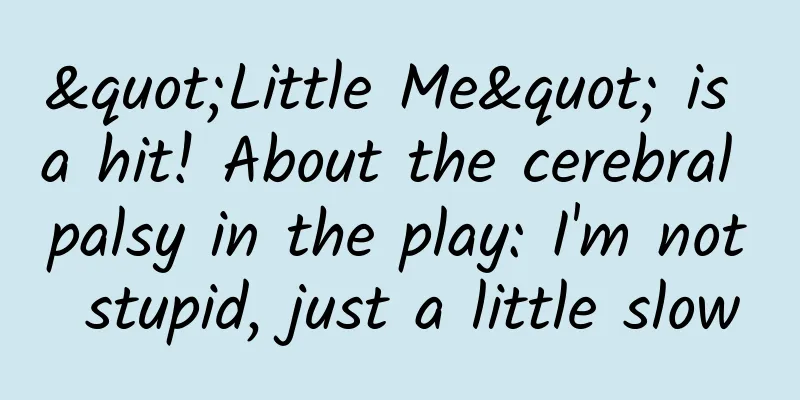"Little Me" is a hit! About the cerebral palsy in the play: I'm not stupid, just a little slow

|
Recently, the movie "Little Me" is being shown in theaters. The film focuses on a special group of people with cerebral palsy. With its sincere emotions and moving stories, it has become one of the most popular movies during the New Year's Day season. ▲Liu Chunhe played by Yi Yang Qianxi In the film, Yi Yang Qianxi plays Liu Chunhe, a cerebral palsy patient who has never given up his love and pursuit of life, but has suffered a lot of loneliness and helplessness due to his limited mobility and unclear pronunciation. "Liu Chunhe is just cerebral palsy, not a fool." This line in the movie is also the voice of Fan Xiong, the prototype of Liu Chunhe. Recently, Xinhua News Agency New Media Center and the "Little Me" film team jointly launched a social name change initiative "Don't Call Me Cerebral Palsy". In order to find a common name that can vividly describe the disease and is easy for the public to understand to replace "cerebral palsy", the name change volunteer team proposed a series of names such as "cerebral palsy", "cerebral movement disorder", "Chow Yun-fat syndrome", "Li De syndrome", etc., and finally found the earliest description of the "five delays" symptoms of "cerebral palsy" by Qing Dynasty physician Zhang Lu in the ancient Chinese medical classic "Zhang's Medical Encyclopedia". Based on this inspiration, the name change team decided to replace "delay" with "slow" which is more suitable for modern communication, and refined the new nickname "five slow syndromes". "Five Slow Diseases", this new name is not a labeling definition, but a call for a deeper understanding and equal treatment of patients by the society. They are just a group of ordinary people who are a little slow. As long as one more person calls them "Five Slow Disease Patients", they will have one more fair chance. A name change may not be enough to completely correct the public's misunderstandings and prejudices in a short period of time, but it can be a starting point, an opportunity to guide people to re-understand the patient group. Where does cerebral palsy come from? Is there really something wrong with their intelligence? Is it possible to fully recover? How should we treat the "Liu Chunhe" in real life? 1. What is cerebral palsy? Cerebral palsy (CP), also known as CP, is a group of persistent central movement and posture development disorders and activity limitation syndromes caused by non-progressive damage to the developing fetal or infant brain, often accompanied by sensory, perceptual, cognitive, communication and behavioral disorders, as well as epilepsy and secondary muscle and skeletal problems. 2. How many people have cerebral palsy? There are more than 17 million people with cerebral palsy in the world. According to reports from home and abroad, the prevalence of cerebral palsy is 1.4-3.2‰, and the prevalence of cerebral palsy in children aged 1-6 in my country is 2.46‰. In China, there are about 6 million people with cerebral palsy. 3. Is cerebral palsy a fool? Cerebral palsy, also known as cerebral palsy, is a developmental disorder characterized by movement disorders. The movement disorders of cerebral palsy are often accompanied by sensory, perceptual, cognitive, communication and behavioral disorders, as well as epilepsy and secondary muscle and bone problems. In the film, although Liu Chunhe is physically limited, his intelligence and emotional world are extremely rich. Liu Chunhe's college entrance examination score is more than 80 points higher than the first-tier line, and his memory is also very good. This reflects an important feature of cerebral palsy patients: their intelligence level is not always proportional to the degree of motor impairment. Although some patients may have cognitive or intellectual disabilities, for the vast majority of patients, their cognitive and intellectual development levels are almost the same as normal people. Some children with cerebral palsy even have higher IQs than ordinary people. They need more attention and understanding from society. 4. Can cerebral palsy be completely cured? Generally speaking, the medical community recognizes that cerebral palsy is incurable , and there is no standard single treatment for cerebral palsy. Cerebral palsy requires multidisciplinary systematic treatment, and each treatment method can solve part of the problem, but it is difficult to solve all the problems of cerebral palsy patients. Sun Yongan, chief physician of the Department of Neurology at Peking University First Hospital, said in an interview with reporters that nerve damage is generally caused by congenital development or acquired damage. If cerebral palsy is caused by poor nerve development in the embryo, it is still difficult to completely cure it even if there is some growth compensation in the future. 5. What causes cerebral palsy? Prenatal factors Premature birth (especially extremely immature babies with gestational age < 28 weeks and birth weight less than 1000g), multiple pregnancy, intrauterine infection, fetal exposure to adverse environment (mother's alcoholism, smoking, drug abuse, exposure to radiation, poisons, high fever), etc. Intrapartum factors Maternal comorbidities and emergencies during labor, such as placental abruption, umbilical cord prolapse, and amniotic fluid embolism, may lead to fetal distress and neonatal asphyxia, thereby causing severe perinatal brain damage. Postpartum factors Brain damage and acute encephalopathy caused by diseases suffered by newborns after birth, such as central nervous system infection, hypoglycemic encephalopathy, bilirubin encephalopathy, and severe intracerebral hemorrhage. Developmental malformations When there are developmental malformations, especially structural malformations of the central nervous system, it may lead to abnormal delivery process and neonatal hypoxia and asphyxia. Genetic factors Studies in recent years have found that among some children with cerebral palsy, there is a tendency for the disease to be related and familial, that is, patients with cerebral palsy appear repeatedly in the same family. Source: Xinhua News Agency, People's Daily Online, Shanghai Disabled Persons' Federation, Digital Beijing Science Center |
Recommend
Be careful! The high incidence age of this cancer is getting earlier! These 5 types of people are most likely to be "targeted"!
Everyone can get cancer. Does cancer attack indis...
Are sun protection clothes just a waste of money? Cooling, moisture absorption, moisturizing... how real are the eye-catching "labels"?
The sun is scorching, the sun is burning the eart...
Don't buy this kind of bread for breakfast, it has more calories than fried chicken
On an ordinary working morning, a worker who was ...
Google Ads Promotion: How to Improve Keyword Rankings?
01. How can I rank at the top of search results? ...
The newly added keywords in the bidding have passed the review, but the quality scores are all 1 point. Why?
If the newly added keywords have not been reviewe...
SKF sued by Daimler for alleged monopoly
According to foreign media reports, SKF was punis...
Is Qingming Festival a legal holiday? What specific day is it? Attached is the Qingming Festival holiday arrangement 2022!
Qingming Festival is just a few days away. On thi...
World Tuberculosis Day丨It is the second largest infectious killer in the world!
Recently, the COVID-19 pandemic has struck again....
More than a year after the Black Soil Protection Law was implemented, what has happened to the "giant pandas" in the cultivated land?
Written by reporter Chen Yongjie Photo and text e...
For the first time, this type of black hole has been discovered in the Milky Way?
An intermediate-mass black hole lurks at the cent...
A powerful APP ad blocking tool appears on iOS: Even Apple APPs cannot escape
[[151278]] In the latest version of iOS9, Apple a...
Can acne be prevented by vaccination? The truth is...
Some people, their youth is gone, but acne still ...
I'm not angry, if I get breast hyperplasia...
I believe many people have heard the saying "...
Tips for editing and producing popular short videos!
With the rise of short videos, everyone with a mo...
Understand from one picture: What are the chances of going from "Yang Kang" to "Wang Chongyang"?
Recently, the number of COVID-19 positive tests i...









